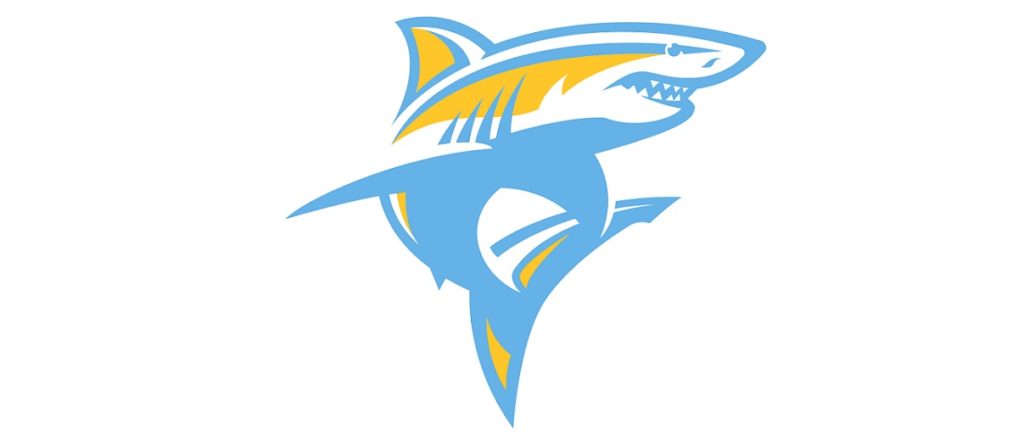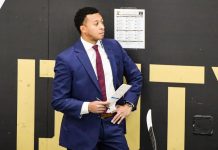
This is Part 3 of a three-part series looking at Long Island University’s impending Division I men’s hockey program.
Long Island University’s decision to add men’s hockey sparked unavoidable discussion throughout college hockey.
The Sharks’ intention to start a program for the upcoming season without a club team foundation created a tall order, and it rippled questions laced with quizzical, curious excitement of the sport’s new home on Long Island:
Who was going to coach? Who was going to play? And where did the school intend to do it?
“I think I’m excited that folks are excited about us,” LIU athletic director Dr. William Martinov said. “That’s a good sign. It means we’ve created opportunities for our student-athletes within our plan, and we’re creating opportunities within these sports. To have a positive reaction is comforting and supportive, but now we have to get to work. We have to get a coach and recruit, and we’ll do that.”
Every school develops its own requirements for each component but remains flexible to the right person. In terms of a coach, a person is more than just a recruiter. The head coach leaves a personalized stamp on a program by drawing players who appreciate a university for its whole pie. Doing that requires a utilization of everything from the academics to the arena to the student body, and it forms an entire experience that collaboratively forms a trademark or reputation.
“At the end of the day, we want a great student-athlete experience,” Martinov said, “so we need the right person. (Women’s coach) Rob Morgan created a culture of success with his philosophy and his program. It was a key component to how he was hired, and we want the same thing for men’s hockey.
“We believe in graduating student-athletes and developing the whole person. We know student-athletes, no matter how great they are, will understand that academics tie into a career for when they hit the workforce (after playing). And if we’re going to play, we want to win. We want to graduate, develop the right person, and win games. It’s important to find the right person that can do all three of those things, and we want to be well-respected for staying true to that.”
Martinov emphasized the need to find the right coach for the university’s values. The vacancy posted online shortly after the university’s program announcement, but understanding who eventually fills the void goes deeper than a job description. It’s a process that preceded the posting as part of the larger conversation about forming the program altogether.
“We had clearly done some work and research on candidates before the announcement,” he said. “Since the announcement, there’s been interest because people are now aware (of our team). We want to have a coach with Division I experience, but it’s a preference. The right person might not check off all the right boxes, but there’s something who convinces you that they’re the right person off the bat. That’s someone who would know how to hustle a little bit more than a program that’s established. It’s a little different walking into a starter program than it is one that’s been around for 20-odd years.”
One of the biggest challenges facing the coach is the overall lack of physical players. LIU doesn’t have a club team with an existing player pool, which is a difference from both Penn State and Arizona State, where successful ACHA teams existed.
“We had a lot of really good players who were great guys in the club program,” Penn State coach Guy Gadowsky said. “They loved Penn State. As a staff, we said off the hop that we were going to be honest, that we wanted to win but that our biggest priority was laying a foundation for the future. We were up front so we could set high expectations for the culture.”
“We kept 16 club players for that (first varsity) year,” Arizona State coach Greg Powers said. “And we won 169 games in the five years I coached them at the club level. We won a lot of games and had a winning culture with kids who were proud of what we built. We transitioned all of that into the hybrid year with a roster that had seven players who played in the USHL, which was unheard of. We were very talented for that level and had transfers from Ferris State, AIC and Northeastern. It set us up to transition very well.”
Robert Morris University, meanwhile, had a more modest start in 2004. The Colonials hired Derek Schooley in 2003 to move the club team to varsity status, but few club players advanced to the Division I roster. Instead of moving a whole team, Schooley spent a year recruiting a roster that stepped on the ice in 2004 with over 20 freshmen and a handful of transfers.
“We didn’t have anything like a transfer portal (in 2003),” Schooley said, “so it was difficult to try and find players at the time. Findlay dropped its program, so we were able to get a player from there. We had a player that transferred during the year we weren’t playing that transferred in around Christmas. We really had to go out and spread the word and find people who wanted to be a part of something special that could grow from the ground.”
What RMU did have was an arena. The university acquired the Island Sports Center right around its announcement of men’s and women’s hockey. It’s still the team’s home and is part of a multipurpose complex serving as a hub of activity.
Like RMU, Penn State had its own facility when it brought Division I hockey into the fold. The only difference was that the Pegula family earmarked funds in its $100 million donation for a 6,000-seat arena now bearing its name. The sparkling new building opened for the first year of full Division I status in State College and replaced the Penn State Ice Pavilion almost immediately.
Arizona State, meanwhile, is in a third boat because the Sun Devils still play at Oceanside Ice Arena in Tempe, Arizona. The program moved to Division I with the understanding that the rink wouldn’t be a long-term, viable solution and made arrangements to play games at Glendale’s Gila River Arena, home of the NHL’s Arizona Coyotes. They will eventually move permanently into a multipurpose arena currently in progress on the team’s campus.
“We knew we didn’t have a suitable facility, long-term, but we were willing to deal with the rigors of playing out of a modest facility,” said Powers. “We intended to play some games in an NHL arena, which we’ve done. It was all part of a growth curve, and we knew we’d have to figure it out as we went along. We know now that it’s taking care of itself and that (a new arena) is coming.”
LIU currently doesn’t have a firm arena but is optimistic that it can at least solidify a relationship with the facilities it used for its women’s program. The Sharks placed eight games last year at the Islanders Iceworks facility in Syosset, N.Y., with an additional six games at the Northwell Health Ice Center in East Meadow, N.Y.
The women’s team also hosted Wisconsin in one game at Nassau Coliseum last year, which underwent extensive renovations after the Islanders departed for the Barclay’s Center. The Islanders since resumed playing there with 28 of their 41 scheduled home games. They also would have hosted a playoff series before the coronavirus crisis postponed the season. Eventually, the Islanders will move into a new arena in Belmont, also on Long Island.
There have been nine new arenas introduced into Division I since 2010 with the most recent launch at Bentley in 2018. Arizona State and Colorado College are currently in the process of moving to new buildings, and Sacred Heart announced a $60 million project this year. It puts an emphasis on facilities growth in college hockey, and it’s why an arena is a primary concern in discussing feasibility for any school considering college hockey.
“We look at a facility, first and foremost, if a school has access to adequate facilities,” College Hockey Inc. executive director Mike Snee said. “That’s a bulk of the cost (of adding hockey) and the biggest barrier.”
College Hockey Inc. is a nonprofit organization dedicated to promoting Division I college hockey to players, fans in emerging or existing hockey markets. It formed as a partnership with USA Hockey and coordinates feasibility studies for prospective hockey schools that are funded by the National Hockey League and the National Hockey League Players Association.
“The main thing we have to offer is the generosity of the National Hockey League and the National Hockey League Players Association,” Snee said. “It can be for just men’s hockey, just women’s hockey, or both, and they’ll fund it.”
Feasibility studies are a relatively new focus for college hockey throughout the country. They take individualized approaches to institutions that may have unknown links to the game in some capacity. There are hundreds of options to sift through, and CHI’s job is to help a school determine a bottom line number more than a final decision.
“The feasibility study doesn’t suggest a team should or shouldn’t (add hockey),” Snee said. “But if they want to add a successful hockey program, it gives out what should be considered. It gives a cost, financial or otherwise, and the school determines if it’s something worth doing. It gives us a reason to keep working with a school if it’s interested.”
“(We) were before feasibility studies were funded by the NHL,” Powers said. “But we investigated how we could make (men’s hockey) work with Title IX and everything. We did a ton of work and had a number of conversations with coaches, other athletic directors, and commissioners. We had detailed conversations with Mike Snee and Nate Ewell from College Hockey Inc. that drove us to believe that we could do it.”
It should be noted that no institution is under any kind of rule or obligation to use CHI, and Long Island University did not contact College Hockey Inc.
“We’re excited that LIU sees the opportunity of adding men’s hockey to their very new women’s team, which had success,” Snee said. “Long term, I think the opportunity to create a college hockey culture on Long Island is exciting.”
That’s a consensus shared by many in college hockey. There was initial shock when Long Island University came from seemingly out of nowhere to become the “61st team.” Long term, it’s an opportunity to create college hockey in one of the nation’s best markets for the sport, a place long on tradition that could embrace the team closest enough to claim New York City as its home.
“We will get this going,” Martinov said. “I think the support of the local communities will always be important. Having men’s and women’s hockey on Long Island, as the only Division I program, I think there are young kids who are hockey players who will build a dream to play at LIU. That’s exciting.”
******
Dear college hockey fans,
The date April 30, 2020 forever changed the face of our sport.
The way we spoke about the sport and the teams that we root and cheer for gained its newest member when Long Island University announced it was adding men’s hockey.
We all had a number of reactions and ranged from shock to excitement to surprise to confusion. None of us in any corner of the sport really saw this coming, and the immediate flourish of reactions caused us all to talk about things that we didn’t really know.
I remember saying on social media that I had so many questions. In that spirit, I set out over the past two weeks to develop some answers. I figured if I had them, people would be willing to talk to me to answer them. I wanted to know about how new programs developed, what drove LIU to consider men’s hockey, and how it would succeed in forming a brand new program with less than six months until the hopeful start of next season. I was curious about the impact hockey had on the universities, and I reached back into history to think about how things differed 20 years ago.
I hope I found most of the answers, and I hope what you will read will answer your questions as well.
In the meantime, I feel like I need to acknowledge a number of people who took time to speak with me. First, I’d like to thank the folks at LIU, especially Casey Snedecor, the director of media relations. She linked me up with Dr. William Martinov, Jr., the school’s athletic director, who spoke with me about his hopes for the upcoming men’s hockey team.
For that, I am also very appreciative of his time and willingness to discuss the team with me.
I owe a big thank you to Guy Gadowsky, Greg Powers, and Derek Schooley, the head coaches of the three newest Division I programs. All three are the inaugural coaches of their respective programs and were part of building efforts at those schools. They took time almost immediately to talk about their challenges and opportunities, dating back over 15 years for Coach Schooley, who I talk to during Atlantic Hockey season.
Thank you to all three eastern leagues – Atlantic Hockey, ECAC, and Hockey East – for providing me timely responses on short notice. And thank you to the Northeast Conference for also providing me with a response.
And thank you to Mike Snee at College Hockey Inc. I know I’m looking forward to seeing everyone again in Pittsburgh for our next Frozen Four, next spring, where I hope, selfishly, an Atlantic Hockey team crashes everyone’s party (sorry, that one was for me!).
I hope you all read this with an open heart and mind. I don’t know if one team can ever say it did something better than another team based on its individual circumstances.
One thing I do know is that more hockey is always a good thing, and we all want LIU’s program to succeed. We want more teams, and we want more teams to succeed on the ice. We all have a vested interest in the 61st team so we can find a program willing to become No. 62.
I hope you all are remaining safe during this time, and I hope you enjoy everything that you’ve read on our pages.
Until next time!
Best,
Dan Rubin


